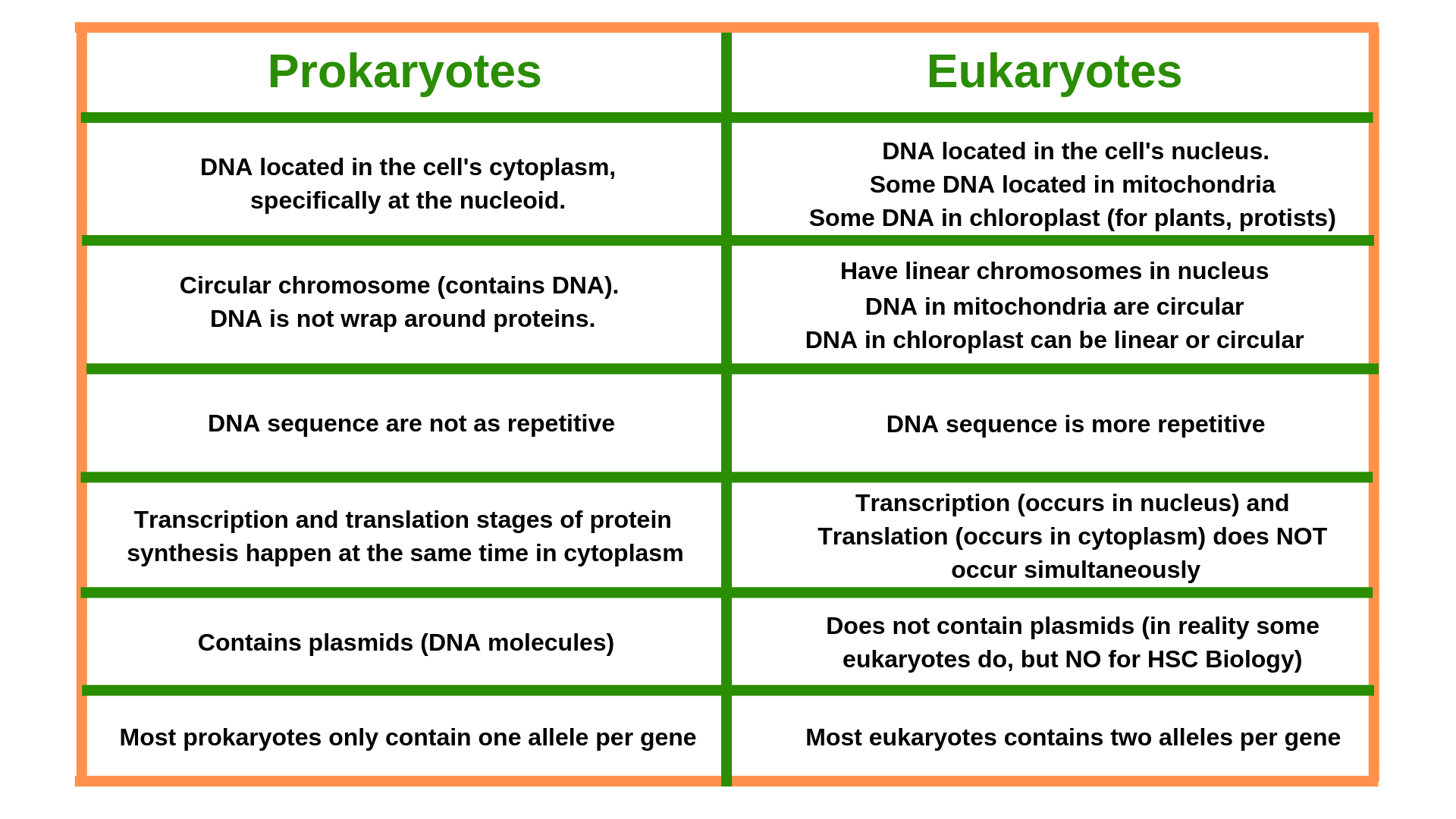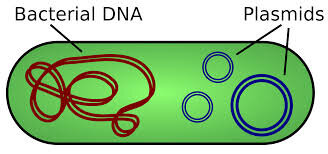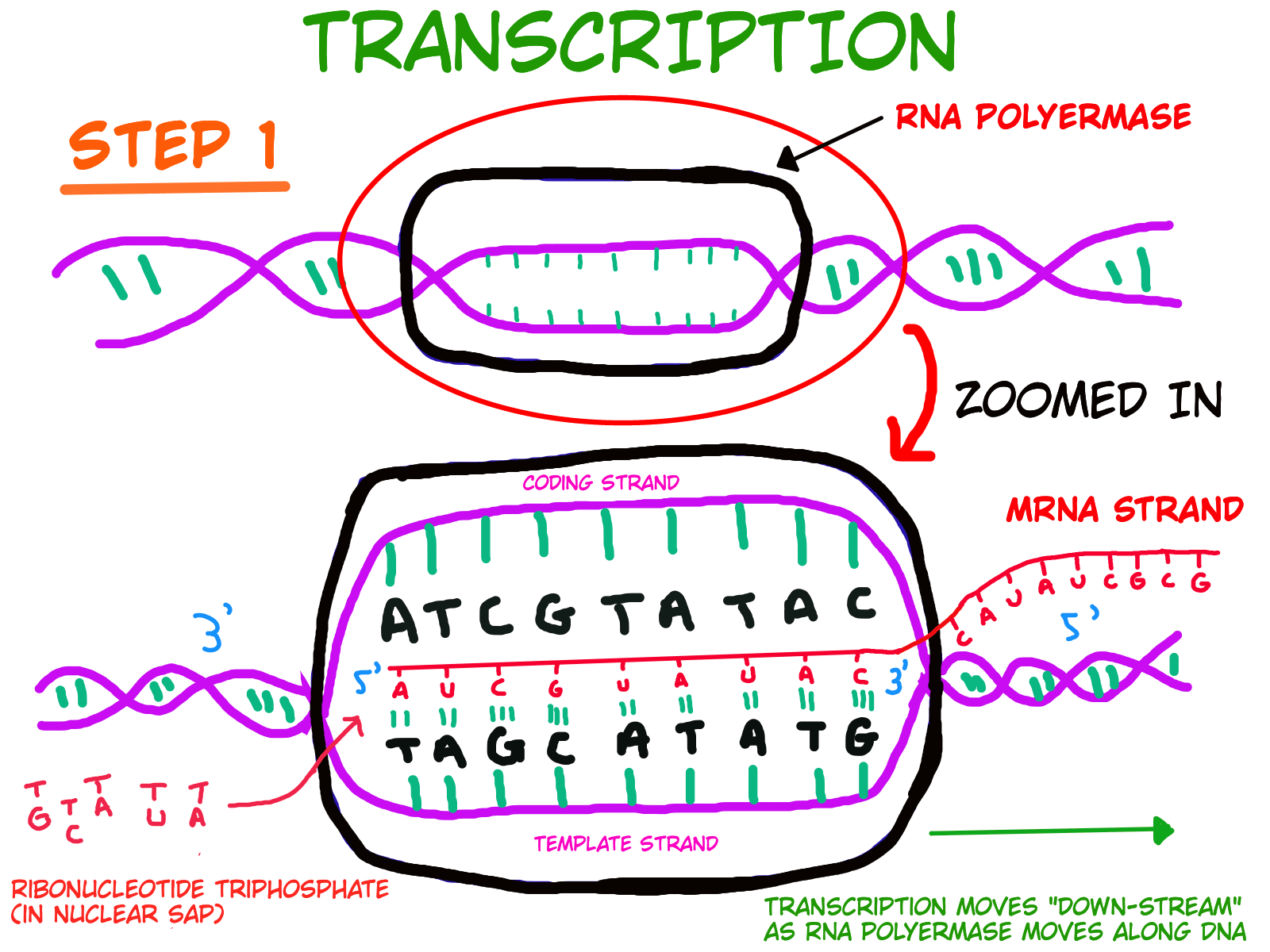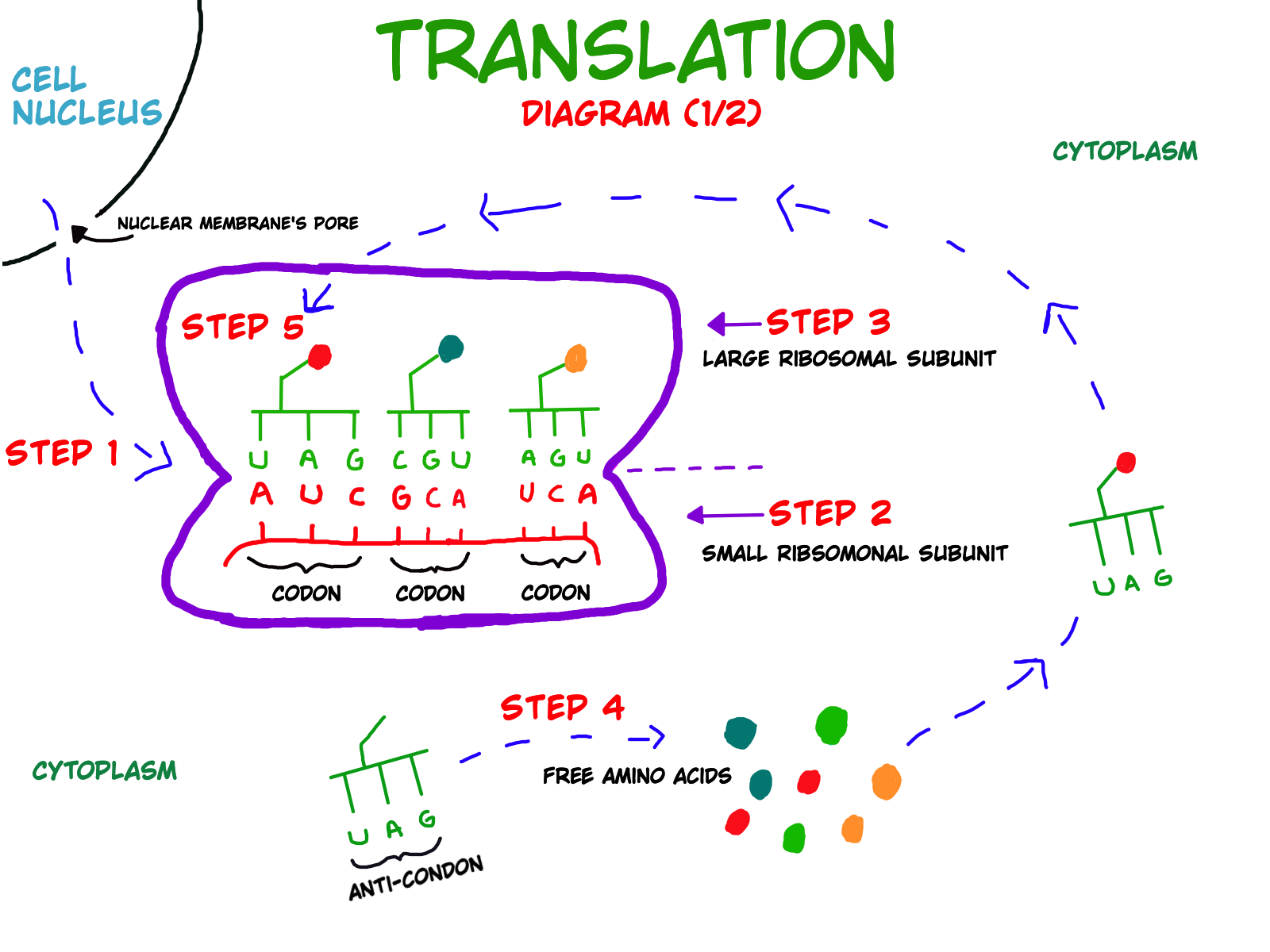HSC Biology Syllabus Notes
Module 5 / Inquiry Question 3
Overview of Week 3 Inquiry Question
Learning Objective #1 – Construct appropriate representations to model the forms in which DNA exists in eukaryotes and prokaryotes
Learning Objective #2 – Model the processes involved in polypeptide synthesis – Transcription
Learning Objective #3 – Model the processes involved in polypeptide synthesis – Translation
Learning Objective #4 – Describe the importance of mRNA and tRNA in transcription and translation
Learning Objective #5 – Analyse the importance and function of polypeptide synthesis
Learning Objective #6 – Assess how genes and environment affect phenotypic expression
Learning Objective #7 – Investigate the structure and function of proteins in living things
NEW HSC Biology Syllabus Video
Week 3 Homework Questions
Week 3 Curveball Questions
Week 3 Extension Questions
Solutions to Week 3 Questions
Overview of Week 3 Inquiry Question
Welcome back to Week 3 of your HSC Biology Syllabus Notes!
So far, in the previous weeks, we have touched on how genetic variation supports the continuity of a species. We have also explored how genetic variation can be created via different processes occurring during meiosis such as crossing over, independent assortment and random segregation. Also, during fertilisation of gametes.
Earlier in Week 1 notes, we briefly mentioned that an organism’s gene contribute towards an organism’s characteristics – structure, physiological and behavioural. In this week, we will learn how an organism’s gene code for a specific polypeptide chain which is used to produce proteins. The proteins are what determine an organism’s phenotype as well as physiological and behavioural traits traits . For example, a protein that codes for an organism’s eye colour (phenotype – physical/structural trait)
It is important to note that the protein synthesis process in living organisms produce protein that are determined by the organisms’ genes. The definition of a gene is a segment of a DNA. So, before we dive into the process of protein synthesis, we need to understand how DNA exists in prokaryotes and eukaryotes living organisms.
Learning Objective #1 - Construct appropriate representations to model the forms in which DNA exists in prokaryotes and eukaryotes
There are two types of DNA namely Chromosomal DNA and Extrachromosomal DNA.
The difference between these two are that the former is located inside a cell’s nucleus whereas the latter is located outside a cell’s nucleus. Remember that there are many cells in the body
Plasmids are circular DNA molecules that are found outside the nucleus in prokaryotes’ cells. Hence, they are a type of extrachromosomal DNA.
Mitochondrial DNA and chloroplast DNA are also classified as extrachromosomal DNA as they are not found within the nucleus of a cell. These two types of circular DNA are found in eukaryotes.
Chromosomes are classified as linear chromosomal DNA as they contain linear DNA and are located within the nucleus of a cell. Chromosomes are found in eukaryotes’ cells.
The table below highlights more differences between the DNA found in the cells of prokaryotes and eukaryotes.
Now, that we have talked about the different forms in which DNA can exist in eukaryotes and prokaryotes, let’s have a look at these different forms of DNA through some visual diagrams.
Prokaryotes - Circular DNA in cytoplasm with Plasmids Model
Prokaryotes have circular DNA as shown in the diagram. In the case of bacteria, it has circular bacterial DNA.
Notice that bacterial DNA is double stranded but it is circular in shape.
Prokaryotes also contain plasmids which are circular DNA molecules.
Eukaryotes - Nuclear DNA Model
Eukaryotes - Mitochondrial DNA Model
Eukaryotes - Chloroplast DNA Model
Now, let’s explore how DNA is involved in the protein synthesis process where proteins produced determine the traits (physical, physiological and behaviour traits) of living organisms.
We will first be focusing on protein synthesis in eukaryotes which consists of two separate stages. i.e. transcription and translation. Then after that, we will look into protein synthesis in prokaryotes.
Learning Objective #2:
Model the process of polypeptide synthesis - Transcription
*Typo in diagram: Ribonucleotide Triphosphate should read Ribonucleoside triphosphate. These are RNA nucleotides.
RNA nucleotides are different to DNA nucleotides as they do not contain thymine nitrogenous base. They have Uracil (U) nitrogenous base instead. Furthermore, they different in their sugar molecule. More specifically,
A RNA nucleotide can have – C, G, A or U nitrogenous bases. Each nucleotide has a ribose sugar and phosphate group.
A DNA nucleotide can have – G, C, A or T nitrogenous base. Each nucleotide has a deoxyribose sugar and phosphate group
In eukaryotes, transcription is the first stage of the two-stage protein synthesis process.
Transcription (‘transcribing’) is the process whereby the genetic information of a gene, situated in DNA strand, is copied to mRNA molecule that is synthesised during the process.
Step 1: RNA polymerase (enzyme) attaches itself to the DNA at the promoter sequence region, breaking the hydrogen bonds that is bonded the nitrogenous bases. This results in the unwinding of a section of the DNA double helix. This process is known as initiation.
Note that RNA polymerase does not unwind the entire DNA molecule, only a section consisting of a gene that is required to code for a particular polypeptide chain.
Step 2: The section of DNA is unwound to allow free ribonucleoside triphosphate molecules to perform complementary base pairing with the template strand of the DNA. That is, Adenine will pair with Uracil and Cytosine will pair with Guanine.
Note that there is NO thymine base in ribonucleoside triphosphate molecules, they are replaced with Uracil. This is because the mRNA molecule consists of Uracil, Adenine, Cytosine and Guanine whereas the DNA strand consists of Thymine, Adenine, Cytosine and Guanine.
NOTE: Only one strand (the template strand) of DNA gets transcribed.
Fun point about enzymes: Most enzymes have their names ending with ‘ase’. For example, DNA polymerase, RNA polymerase and helicase.
Step 3: RNA polymerase moves downstream of the DNA (from 3′ to 5′ as shown in diagram) as more nitrogenous bases on the template strand are being paired with ribonucleoside triphosphate. These free RNA nucleotides are found in the nuclear sap, this is the same place where the free nucleotides are found during DNA replication. This process is known as elongation or sometimes also referred to as propagation because more RNA nucleotides are being paired with the nitrogenous bases on the template strand. As RNA polymerase moves downstream of the DNA, the enzyme rewinds the DNA behind it to reform the double helix.
Step 4: The propagation stage of transcription stops when the RNA polymerase arrives at a termination sequence. Here, the enzyme releases the chain of ribonucleoside triphosphate from the complex, creating an mRNA strand that has identical genetic information as the coding strand of the DNA (only difference is that uracil is present rather than thymine) as it is formed via complementary base pairing using the template DNA strand.
Learning Objective #3:
Model the process of polypeptide synthesis - Translation
Translation is the process whereby mRNA information is used to create polypeptide chain and specifying its amino acid sequence.
A polypeptide chain is consist of a chain of amino acids. There are proteins that are only made up of one polypeptide chain but there are also proteins that are made up of more than one polypeptide chain.
Step 1: The mRNA migrates out of the cell nucleus and into the cell’s cytoplasm via the nuclear membrane pore.
Step 2: A small ribosomal unit attaches to the mRNA
Step 3: Following the small ribosomal unit, the large ribosomal unit attaches to the mRNA
With the mRNA enclosed by the ribosome, it means that translation occurs within ribosomes. The rough endoplasmic reticulum (organelle) contains many ribosomes on its surface. This was from the Year 11 Preliminary HSC Biology Syllabus.
Step 4: There are tRNA molecules found in the cytoplasm that have an anticodon. One anticodon is made up of three RNA nucleotides, each RNA nucleotide has a nitrogenous base – A, U, C or G. Each of these tRNA molecules can bind with a specific type of amino acid that is specific to its anticodon. This binding process requires the assistance of an enzyme (enzyme name not necessary for HSC Biology).
Step 5: The mRNA codon specifies the tRNA, carrying an amino acid, with the complementary anticodon to bind with itself. The ribosome reads the mRNA codons so that the tRNA molecules with the correct anticodon bind with the correct mRNA codon.
Note: Each codon (a sequence of three RNA nucleotide) on the mRNA strand will specify the tRNA anticodon for successful binding. For example, an mRNA with the codon AUC will specify and only allow an tRNA molecule with the UAG anticodon to bind with it.
In effect, each mRNA codon specifies a tRNA molecule (based on complementary anticodon) and, thus, specifies the amino acid. Hence, the amino acid is specific to the mRNA codon (as well as specific to tRNA anticodon, of course).
In the HSC Exam: You will be expected to know that each mRNA codon specifies an amino acid. This is why the translation table shows the mRNA codon that corresponds to an amino acid.
Step 6: As the next mRNA codon specifies the another tRNA to bind with it, the prior tRNA molecule will detach from the mRNA and ‘transfer’ its amino acid to the new tRNA molecule that entered the ribosome complex. The amino acids undergo a condensation chemical reaction to bond with each other via a peptide bond. As this elongation process of building the amino acid chain progresses, the ribosome unit moves along the mRNA to continue reading subsequent mRNA codons.
Step 7: The elongation process of building the amino acid chain stops when the ribosome complex reads the mRNA stop codon (a sequence of three RNA nucleotides). At this stage, a release factor comes into ribosome and binds with stop codon. This release factor causes the amino acid chain to separate from the tRNA molecule, resulting a polypeptide chain.
Step 8: The ribosome complex separates into its small and large ribosomal subunits and mRNA separates into its individual nucleotides, i.e. ribonucleoside triphosphate.
Step 9: The polypeptide chain coils up as the amino acids forms hydrogen bonding with each other. This single polypeptide can be a protein. (In diagram, I added extra amino acids, solely to depict coiling of polypeptide).
NOTE for Step 9: Whether or not this polypeptide is a protein will depend on the type of protein that the original organism’s gene was expressing at the start of protein-synthesis. However, if the expressed protein has only required one polypeptide chain then it will be called a protein. If the protein to be expressed requires more than one polypeptide, then the polypeptide chain form will interact and bond with other polypeptides which together will fold or coil to form the protein.
Protein Synthesis in Prokaryotes
What we have just explored is protein-synthesis in eukaryotes. But how does the process of protein-synthesis differ in prokaryotes? Let’s find out
In eukaryotes’ protein-synthesis there are regions called introns and exons. Exons are areas responsible gene expression and introns are non-coding regions of DNA that does not specify for an amino acid. Both of these DNA sequences get copied to the mRNA strand.
Before translation, splicing occurs where introns DNA segments are removed from the mRNA strand.
For prokaryotes, they have minimal introns and thus splicing is rarely occurs.
In prokaryotes, transcription and translation occur simultaneously rather as separate steps because prokaryotes’ DNA are not separated from the cytoplasm via nuclear membrane.
Lastly, each mRNA in prokaryotes contains genetic information from multiple genes. Comparatively, each mRNA in eukaryotes contain genetic information for only a single gene.
So, in general, this means one mRNA in a prokaryote can code for more than one polypeptide compared to one mRNA in an eukaryote
Learning Objective #4 - The importance of mRNA
Part of the transcription involves the creation of a mRNA molecule that contains nitrogenous bases that are complementary to those nitrogenous bases found in the template strand or identical to nitrogenous base to those bases found in the DNA coding strand (except that uracil is present rather than thymine).
From this, we can see that mRNA is important in ensuring that the organisms’ genes code for the correct mRNA codons. This allows the correct tRNA molecule with matching anticodons that correct the amino acid that corresponds to the mRNA codon to form the correct amino acid sequence for the polypeptide chain. Thus, the polypeptide chain(s) can fold correctly resulting in a correct protein structure and function.
I know the word ‘correct’ was used many times there but that was for you to understand how the amino acid attached to the mRNA is SPECIFIC to the mRNA codon!
So, how can i word this in the exam without being repetitive you say? Well, In the exam, you can write the following: The correct gene will allow the correct mRNA, formed from complementary base pair, to specify the correct tRNA carrying a specific amino acid to bind with the matching mRNA codon. This ensures that the right amino acids sequence of the resulting polypeptide chain and, hence, the correct protein to be created.
Learning Objective #4 - The importance of tRNA
The tRNA’s role is important in ensuring that it’s anticodon specifies and binds to the correct amino acid. This will ensure that the resulting polypeptide chain will have the right amino acid sequence that allow the protein-folding process to occur correctly. If not, the protein will not have the correct shape (primary structure)! The shape of the protein is critical in determining its function!
This can be seen in the example of enzymes, a type of protein.
Without enzymes, many metabolic processes such as cellular respiration simply will not occur as the reactants will not form chemical bonds with each other to create the products.
The enzymes involved in catalysing mammals’ metabolic processes are proteins. Enzymes allows reactions to occur with lower energy at faster rates. Enzymes work by binding reactants together at the enzymes’ active site to weaken their chemical bonds and create products.
The enzyme’s active site is critical in ensuring that the enzyme is able to attach the specific reactants by their specific shape. The enzyme’s active site and the specific reactants’ shape matches specifically! So, if the enzymes’ (protein) shape is not correct due to incorrect amino acid sequence in protein synthesis, the enzymes’ (protein) cannot correctly perform its function in catalysing the required metabolic process such as cellular respiration.
Without cellular respiration, the cells of the organism will not be able to able ATP (Energy). Without specific energy, the organism cannot perform daily activities such as hunting for food, cell growth, cell repair, cell division, maintain its core temperature, or even walk.
This means that the organism will die.
Apart from enzymes being made up of proteins, it is important to note that proteins also specify an organism’s characteristics (structural/physical, physiological and behavioural traits). A structural (or physical) characteristic may be hair colour. The details of how this works is beyond the HSC Biology Syllabus.
In the final learning objective of this week’s notes, we will explore more examples of proteins, apart from enzymes which we just talked about, in terms of how their structure is related to their functions.
So, to wrap up, we should now realise that proteins are important. Protein shape is important to their function. Therefore, the right amino acid sequence is important as well as the right mRNA codon sequence and, hence, DNA is important.
Previously, we have touched on the importance of DNA in terms of how genetic variation (allele combinations) are important in specifying the right characteristics of an organism for tolerating against ambient environment’s selective pressures.
Now, we have touched on how DNA is important coding for the right protein which specifics for physical traits as well as catalysing necessary metabolic processes. We have come a long way already :)
Learning Objective #5 - Analyse the importance and function of polypeptide synthesis
This learning objective would be related to the purpose and importance in creating polypeptide chains and therefore proteins.
This has already been discussed towards the end of the the previous learning objective. So, scroll up a little to refresh your mind (if you are returning to this set of notes for exam revision).
However, to add on to what has already been said, here are some more pointers that is specific to this learning objective.
As already mentioned, gene expression refers to process whereby polypeptides are produced by the coding of genes. Hence, gene expression is part of the polypeptide synthesis and, thus, protein synthesis process. Polypeptide synthesis is a highly regulated process.
For example, our white blood cells only produce proteins known as antibodies to immobilise and defend against foreign matter such as bacteria when necessary. After a successful defence, our white blood cells will stop producing antibodies. That is, gene expression will stop (we will learn more about regulatory DNA sequences that control gene expression in Module 6).
While antibodies are only produced when the first and second line of defence has failed to defend against foreign matter such as bacteria.
Haemoglobin is a protein molecule that is inside our red blood cells are continuously produced in the bone marrow. Haemoglobin is a protein that is made up of four polypeptide chain and helps increase the amount of oxygen that our red blood cells can carry to our cells for cellular respiration.
Learning Objective #6 - Assess how genes and environment affect phenotypic expression
The relationship between genes and phenotypic expression
This has already been discussed. The flow chart below summarises the process of how genes are responsible for an organism’s traits via protein synthesis.
Gene —> mRNA —> tRNA attached to amino acid —> Polypeptide chain —> Protein —> Codes for a characteristic which can be structural, physiological or behavioural.
For example, a structural or physical trait can be eye colour.
In reality, most traits are specified by more than one gene.
The relationship between environment and phenotypic expression
So far, we have touched on how gene expression in protein synthesis is responsible for an organism’s phenotype.
However, what studies have found is that there are in fact many environmental factors that will affect an organism’s gene expression and thus phenotype
Some examples are outlined below.
The organism’s diet or availability of food/water: Pea plants that have limited availability of water would be shorter than pea plants that have access to abundant volumes of water, provided their pea plants are genetically identical.
pH of soil: Hydrangeas exhibit pink and blue colours depending on the pH of the soil. If the soil pH is less than 6, the hydrangeas will be blue. If the pH is greater than 7, they are pink. Hydrangeas colour are dependent on the concentration of aluminium ions in the soil where ion availability is affected by pH.
Temperature of ambient environment: Himalayan rabbits are found to have different fur colour based on temperature affecting their gene expression in producing fur pigments. Above thirty five degrees celsius, they have white fur (better at reflecting heat). Below thirty degrees celsius, they have black fur (better at absorbing and trapping heat).
You will learn about mutation in future modules. However, just to touch on it a little bit, mutations can also affect an organism’s phenotype by altering an organism’s DNA sequence. For example, UV radiation will modify the DNA sequence of a gene. If the mutation affects a gene that is a oncogene which controls cell growth, then the mutation may lead to uncontrolled growth of unspecialised cells (cancer cells). These unspecialised cells take the nutrients from surrounding specialised (useful) cells, leading to the death of specialised cells and increasing numbers of unspecialised cells (cancer cells). Such abnormal cell growth may appear as ‘bumps’ on an organism’s phenotype.
In short, you can think that Genotype + Environmental Factors = Phenotype.
Learning Objective #7 - Investigate the structure and function of proteins in living things
We have already briefly touched on the relationship between protein structure and function in living organisms. R
ecall that in learning objective #4, we used the example of enzymes (example of a type of protein) and their unique active site’s shape (protein structure) in catalysing specific chemical reactions by binding to specific reactants (protein function as catalyst for metabolic processes).
To add what we have already explored in learning objective #4, for this learning objective, we will explore couple of more examples of how proteins can perform various functions and how their structure help support the protein’s success in performing such activities.
Keratin is a protein that has the function in providing the structure for an organism. Specifically, keratin provides the flexibility of an organism’s skin (protein’s function). The highly-coiled, rope-like protein structure of keratin allows the protein to stretch by without snapping (i.e. chemical bonds does not break), thus, allows the skin to withstand stretching forces.
Another example is involves protein that adopt the function as part of an organism’s immune response. In short, when a foreign substance such as a bacteria enters the organism’s blood stream, plasma B cells gets activated leading to the release of proteins called antibodies. These antibodies are produced (via gene expression) have the same shape as the antigen (proteins) on the bacteria. This allowed antibody to bind with the antigen and neutralise the bacteria, preventing the bacteria to produce any toxic chemicals.
Note that this is an investigation task. So, if you wish you can do further research other types of proteins that exist in living organisms. During your research, you can then document how the protein’s structure is related to their specific function in supporting the survival of the living organism.
More on protein structure specifically
In terms of protein structure specifically, there can be four levels of structure for a protein:
Primary structure, secondary structure, tertiary structure and quaternary structure.
Primary structure – is related to the amino acid sequence of the polypeptide chain(s). The way amino acids are ordered will determine how chemical bonds can and cannot be formed between amino acids. The primary structure is critical in determining how the secondary, tertiary and quaternary structures (shape) would be like! Remember, protein shape is related to its function.
Secondary structure – is related to the way that each polypeptide chain will coil up into helixes by forming more hydrogen bonds between carboxyl and amine groups. Secondary structure is critical in providing chemical stability to polypeptide chains.
Tertiary structure – is related to the way that the now-coiled-up polypeptide chains further coils up to form an irregular three-dimensional structure. This is critical in providing the shape of the eventual protein which is critical for the protein’s function. Up until this point, the main forms of chemical bonds are hydrogen bonding. However, to create this tertiary structure, there are other forms of bonds including ionic bonds. These new bonds increases the protein’s ability to tolerate variations in pH and temperature. However, at the end of the day, the range of temperatures and pH in which proteins can operate efficiently are generally quite narrow.
Quaternary structure – is related to the way different polypeptides interact with each other via hydrogen bonding, forming a functional protein such as an enzyme that is able to catalyse a chemical reaction. If you zoom into any section of the quaternary structure of the protein using an electron microscope, you will be able to see first see the tertiary structure then secondary structure and eventually the primary structure (amino acid sequence) of the protein.
Week 3 Homework Questions
Week 3 Homework Question #1: What is difference between genome, genotype and phenotype? (4 marks)
Week 3 Homework Question #2: Explain why there are two stages of protein-synthesis in eukaryotes and only one in prokaryotes (3 marks)
Week 3 Homework Question #3: Describe the process of transcription in protein-synthesis (4 marks)
Week 3 Homework Question #4: Describe the process of translation in protein-synthesis (4 marks)
Week 3 Homework Question 5: Explain how environmental factors are contribute towards an organism’s phenotype (4 marks)
Week 3 Homework Question 6: Distinguish between eukaryotes and prokaryotes in terms of how DNA exists in their cell(s). (4 marks)
Week 3 Homework Question 7: Explain how genes contribute towards an organism’s phenotype (4 marks)
Week 3 Homework Question 8: Describe the importance of mRNA (3 marks)
Week 3 Homework Question 9: Describe the importance of tRNA (3 marks)
Week 3 Homework Question 10: Explain how the structure of protein is related to its function, provide two examples in your answer (4 marks)
Week 3 Curveball Questions
Curveball Question 1: Explain the importance of polypeptide synthesis (8 marks)
Curveball Question 2: Explain the specific relationship between mRNA, tRNA and amino acids (5 marks)
Curveball Question 3: Assess whether errors in DNA replication (e.g. an adenine base pairs with a cytosine base instead of thymine), may affect an organism’s phenotype and thus the continuity of species. Include the mechanisms of transcription and translation in your answer (8 marks)
Curveball Question 4: Describe the importance of mRNA and tRNA for the survival of a living organism and in supporting the continuity of a species’s population (4 marks)
Curveball Question 5: Describe the four different levels structures of a protein may have (4 marks)
True or False: Errors during interphase I of meiosis may change the phenotype of the organism (parent)?
True or False: Errors during Interphase I of meiosis may change the phenotype of the organism’s offspring?
True or False: Errors during Interphase I of mitosis may change the phenotype of the organism (parent)?








